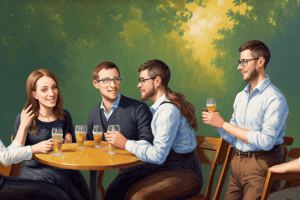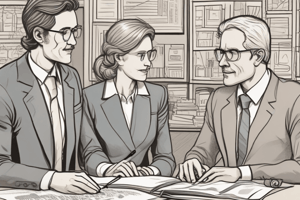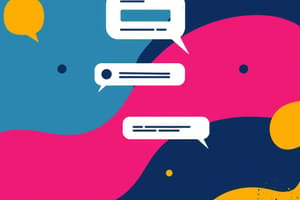Podcast
Questions and Answers
What is conversation design about?
What is conversation design about?
- Only writing dialog
- Being strategic and systematic about what you say and how you say it (correct)
- Conducting usability testing
- Creating a document that lays out what your conversation aims to accomplish
What happens in the 'Discover' segment of the conversation design process?
What happens in the 'Discover' segment of the conversation design process?
- Gathering requirements from stakeholders and conducting relevant research (correct)
- Creating a document that lays out what your conversation aims to accomplish
- Producing the information architecture (IA) in a flowchart
- Crafting the discourse and copy for what the bot will say to users
What is similar between the conversation design process and any product design process?
What is similar between the conversation design process and any product design process?
- The process as a whole (correct)
- The length of time spent in each segment
- The involvement of stakeholders
- The relevance of research
Why is it important to have a team effort in conversation design?
Why is it important to have a team effort in conversation design?
What happens in the 'Prototype' segment of the conversation design process?
What happens in the 'Prototype' segment of the conversation design process?
What happens in the 'Revise' segment of the conversation design process?
What happens in the 'Revise' segment of the conversation design process?
Who is involved in the conversation design process?
Who is involved in the conversation design process?
What is an important aspect of conversation design?
What is an important aspect of conversation design?
What is the purpose of creating an information architecture for a bot?
What is the purpose of creating an information architecture for a bot?
What is a key component of a conversation designer's strategy?
What is a key component of a conversation designer's strategy?
What is the outcome of a well-designed conversation?
What is the outcome of a well-designed conversation?
What is the focus of the next unit in conversation design?
What is the focus of the next unit in conversation design?
What is the primary role of a subject matter expert in conversation design?
What is the primary role of a subject matter expert in conversation design?
Which stakeholders are responsible for ensuring the bot does not break any laws or pose legal risks?
Which stakeholders are responsible for ensuring the bot does not break any laws or pose legal risks?
What is the primary output of a conversation designer's work?
What is the primary output of a conversation designer's work?
Which stakeholders are responsible for creating the graphical expression of the corporate brand?
Which stakeholders are responsible for creating the graphical expression of the corporate brand?
What is the primary role of a project/product owner in conversation design?
What is the primary role of a project/product owner in conversation design?
What do business analysts/data scientists identify in the bot's performance data?
What do business analysts/data scientists identify in the bot's performance data?
Which stakeholders are responsible for customizing the voice of the bot?
Which stakeholders are responsible for customizing the voice of the bot?
What is the primary role of systems/tools admins (ops) in conversation design?
What is the primary role of systems/tools admins (ops) in conversation design?
What is the primary focus of a conversation designer's day-to-day work?
What is the primary focus of a conversation designer's day-to-day work?
What is the role of documentation, content strategy, and content experience stakeholders?
What is the role of documentation, content strategy, and content experience stakeholders?
Flashcards are hidden until you start studying
Study Notes
The Conversation Design Process
Conversation design involves strategic and systematic planning of dialogues. It requires collaboration and effort, not just writing dialog. The process is similar to product design, divided into four stages:
- Discover: Gather requirements from stakeholders and conduct relevant research.
- Ideate: Create a document outlining the conversation's objectives and desired user experience.
- Prototype: Develop the information architecture (IA) with flowcharts, menus, and the voice/tone of the bot. Write the actual dialog and assemble it in a prototyping tool.
- Revise: Conduct usability testing, review with stakeholders for final approvals, and conduct quality assurance (QA) in the final build.
Stakeholders in Conversation Design
Conversation design is a team effort, involving various stakeholders:
- Documentation, Content Strategy, Content Experience: Interface between marketing and copy creators.
- Subject Matter Expert (SME): Provides domain-specific knowledge to ensure the bot's voice and terminology are authentic.
- Marketing: Ensures the bot's style aligns with the corporate brand and voice.
- User Experience (UX)/Design: Integrates the bot within the broader user experience.
- Legal: Ensures compliance with laws and mitigates legal risks.
- Engineering: Customizes the bot, especially for voice, with technical expertise.
- Project/Product Owner: Coordinates efforts across teams.
- Systems/Tools Admins (Ops): Manages systems permissions and technical tasks.
- Business Analyst/Data Scientist: Analyzes data points to identify issues and improvements.
Day-to-Day Tasks
Tasks vary based on project size and team, but generally include:
- Context Setting, Stakeholder Alignment, and Gathering Requirements: Medium to large task.
- Research: Small to medium task.
- Creating User Experience Vision: Medium to large task.
- Information Architecture and Copywriting: Large to extra-large tasks.
- Revisions, Testing, and QA: Extra-large task.
Outputs of Conversation Design
A conversation designer works on:
- Vision for Conversational Experience: Defines how customers interact with the brand through conversations.
- Strategy and Tactics: Outlines the bot's functionalities and main use cases.
- Information Architecture Flowchart: Shows the structure of dialogs and decision-making processes.
- Sample Dialogs and Prototypes: Demonstrates the bot's conversational flow.
- Annotated Transcript: Provides insights into design decisions and potential issues.
What You Make
Vision of Conversational Experience
Conversation designers craft a vision for how customers interact with the brand via voice or text. This often involves creating a slide deck or similar presentation to highlight key aspects such as voice and tone, inclusivity, relationship building, and user needs.
Bot Strategy and Functionality
Designers outline the bot's expected behaviors and main use cases. This includes:
- Information Architecture Flowchart: Shows how dialogs fit together.
- Turn-Taking Structure: Defines how the bot and user interact.
- Sample Dialogs: Written examples of conversations in the bot's voice.
- Prototyping: Using tools like Botsociety, Botmock, Voiceflow, or Rasa to create a video demo or text-to-speech simulation.
- Annotated Transcript: Explains design decisions and highlights potential issues, delivered in a commonly used format (e.g., presentation deck or spreadsheet).
Information Architecture
A detailed flow chart of the bot’s decision-making process, showing which dialogs are triggered by user actions and responses.
Conclusion
By creating a comprehensive vision, detailed strategy, and thorough documentation, conversation designers ensure effective and engaging user interactions. The next unit will explore strategies for achieving high-quality conversations.
Studying That Suits You
Use AI to generate personalized quizzes and flashcards to suit your learning preferences.





